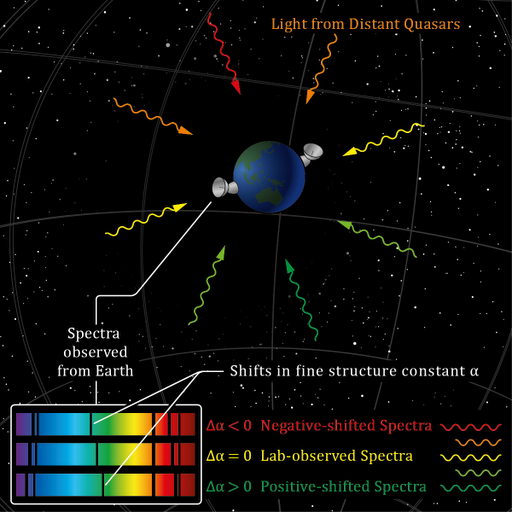That means the laws of physics would vary throughout the universe also.
The arXiv preprint describes how they determined that the fine-structure constant 'alpha' varies by measuring light from a quasar as it red-shifted due to universal expansion.
Their conclusions are based on measurements taken with the Very Large Telescope (VLT) in Chile, along with previous measurements from the world’s largest optical telescopes at the Keck Observatory in Hawaii. Julian King from the University of New South Wales said the different measurement locations were key. "The Keck telescopes and the VLT are in different hemispheres – they look in different directions through the universe. Looking to the north with Keck we see, on average, a smaller alpha in distant galaxies, but when looking south with the VLT we see a larger alpha."

Illustration of the dipolar variation in the fine-structure constant, alpha, across the sky, as seen by the two telescopes used in the work: the Keck telescope in Hawaii and the ESO Very Large Telescope in Chile. Credit: Copyright Dr. Julian Berengut, UNSW, 2010, used with permission.
“After measuring alpha in around 300 distant galaxies, a consistency emerged: this magic number, which tells us the strength of electromagnetism, is not the same everywhere as it is here on Earth, and seems to vary continuously along a preferred axis through the universe,” said Professor John Webb of the University of New South Wales. “The implications for our current understanding of science are profound. If the laws of physics turn out to be merely 'local by-laws', it might be that whilst our observable part of the universe favours the existence of life and human beings, other far more distant regions may exist where different laws preclude the formation of life, at least as we know it.
“If our results are correct, clearly we shall need new physical theories to satisfactorily describe them.”
Video shows the path of light as a beam as it travels from the quasar, through an intervening galaxy and then to the Earth where we capture it with our telescopes. The inset shows the quasar spectrum as it is redshifted (due to the expansion of the universe as it travels) and as it is imprinted with the absorption signature of the intervening galaxy. Credit: Michael Murphy
"It varies by only a tiny amount – about one part in 100,000 – over most of the observable universe, but it's possible that much larger variations could occur beyond our observable horizon," King said.
If it passes peer review - and the lack of peer review is something mass media accounts will fail to disclose - it could force scientists to rethink their understanding of natural laws. "The fine structure constant, and other fundamental constants, are absolutely central to our current theory of physics. If they really do vary, we'll need a better, deeper theory," said Dr. Michael Murphy from Swinburne University. "While a 'varying constant' would shake our understanding of the world around us extraordinary claims require extraordinary evidence. What we're finding is extraordinary, no doubt about that.
"It's one of the biggest questions of modern science – are the laws of physics the same everywhere in the universe and throughout its entire history? We're determined to answer this burning question one way or the other."
Other researchers involved in the research are Professor Victor Flambaum and PhD student Matthew Bainbridge from the University of New South Wales, and Professor Bob Carswell at the University of Cambridge (UK).
arXiv preprint: J. K. Webb, J. A. King, M. T. Murphy, V. V. Flambaum, R. F. Carswell, M. B. Bainbridge, 'Evidence for spatial variation of the fine structure constant', arXiv:1008.3907v1






Comments